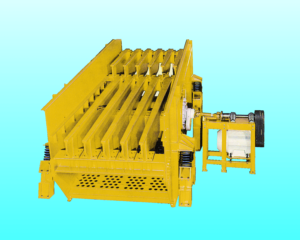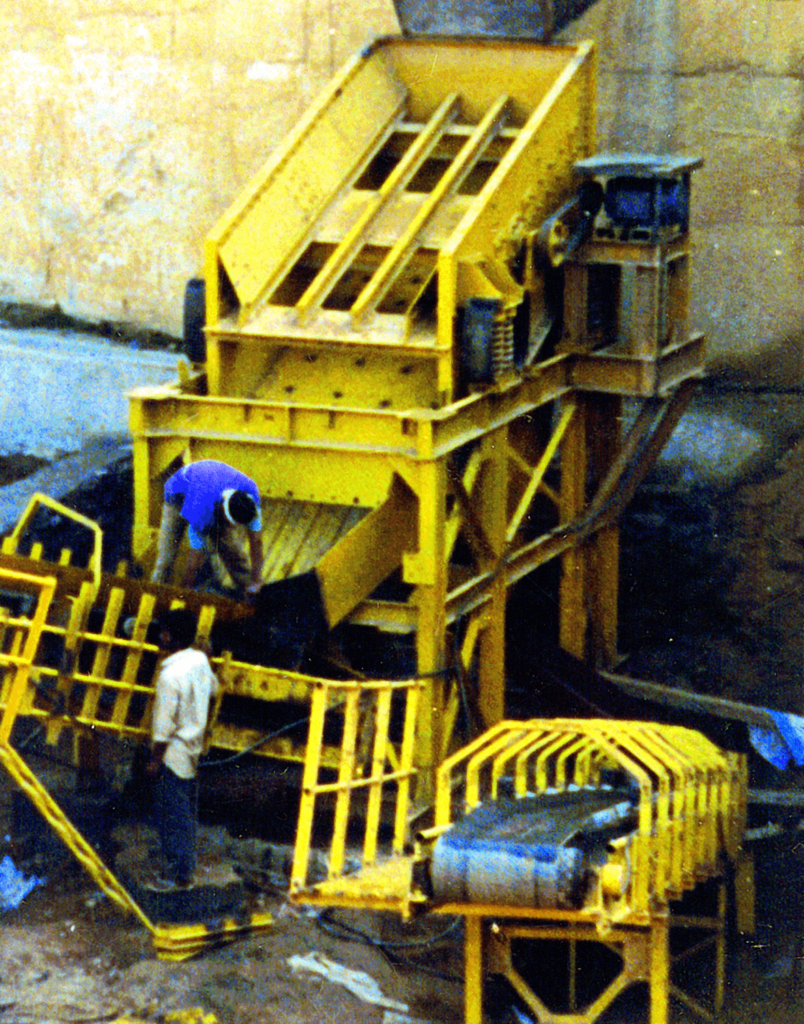
Vibrating Feeder
Smooth Stone Flow Tech
What is a Vibrating Feeder?
A Vibrating Feeder is a robust piece of equipment designed to transport or feed bulk materials into another machine or process steadily and continuously. Its primary function is to evenly, consistently, and efficiently transfer materials from a hopper or a storage unit to a receiving device. The key components of a Vibrating Feeder include a trough, a drive unit (commonly vibrating motors or electromagnetic drives), springs, and a control system.
Specifications include:
- 2-stage and 3-stage
- Capacity : 20 TPH to 500 TPH
- Feed size : 300 – 700 mm and below
- Output size : 40 mm and below
- Price : INR 1.0 – 5.5 crore
- Power Source : Electricity or diesel generators
- Flexibility : Customized based on specific requirements
How does a Vibrating Feeder Work?
At its core, a vibrating feeder employs the principles of vibration and gravity to move materials. The feeder consists of a vibrating base with an inclined or horizontal trough and a mechanism that imparts vibrations. As the feeder vibrates, the material within the trough is propelled forward, creating a controlled and even flow towards the crusher. This vibration-induced motion facilitates the efficient processing of large quantities of material.
Advantages of Vibrating Feeder
- Precision and Control: Adjustable settings enable operators to fine-tune vibrations, ensuring a controlled feed and preventing overloading.
- Uniform Material Distribution: Vibrating motion ensures even material discharge, preventing clumping and maintaining a consistent feed for downstream processes.
- Efficient Scalping and Screening: Excels in separating fines and undersized materials, enhancing system efficiency and protecting downstream equipment.
- Adaptability to Varied Material Types: Versatile handling of a wide range of materials, making them suitable for diverse stone crushing applications.
- Reduced Maintenance Downtime: Robust design and minimal moving parts translate to low-maintenance requirements, minimizing downtime.
Vibrating Feeder Assembly Process
-
Design and Fabrication: The process begins with meticulous design and material selection. The trough, drive unit, springs, and control system are manufactured to meet specific requirements and industry standards.
-
Trough Welding: The trough is welded with precision to ensure durability and structural integrity. The design of the trough is tailored to the material characteristics and the operational needs of the Vibrating Feeder.
-
Drive Unit Integration: The drive unit, whether it be vibrating motors or electromagnetic drives, is integrated into the system. This involves securing the motor, connecting it to the trough, and ensuring proper alignment for optimal performance.
-
Spring Installation: Springs are strategically placed to counteract the dynamic forces generated by the vibrations. Proper installation and tensioning of the springs are critical for the feeder’s stability and longevity.
-
Control System Integration: The control system, equipped with sensors and adjustable settings, is integrated into the feeder. This allows for precise control over the feed rate, amplitude, and other operational parameters.
-
Testing and Quality Assurance: Before the Vibrating Feeder is shipped out, rigorous testing is conducted to ensure that all components work harmoniously. This includes functional tests, vibration analysis, and quality checks to guarantee the equipment meets or exceeds industry standards.
-
Shipping and Installation: Once assembly and testing are complete, the Vibrating Feeder is carefully packaged and shipped to its destination. Installation is carried out by trained professionals, ensuring proper setup and alignment.
Types of Vibrating Feeder
- Vibratory Bowl Feeders:
-
- Suited for small to medium-sized materials.
- Circular design with a spiral track for controlled movement.
- Grizzly Feeders:
-
- Ideal for heavy-duty applications and large-sized materials.
- Equipped with robust bars or rails to pre-screen and filter materials.
- Electromagnetic Vibratory Feeders:
-
- Utilize electromagnetic drives for precise and adjustable feed control.
- Suitable for delicate materials and applications requiring fine-tuned regulation.
- Apron Feeders:
-
- Employ overlapping pans or plates for handling abrasive and large-sized materials.
- Well-suited for harsh operating conditions.
Checklist for Choosing the Best Vibrating Feeder:
- Material Characteristics: Consider the size, density, and abrasiveness of the materials to ensure compatibility with the feeder.
- Capacity Requirements: Determine the required capacity of the feeder to match the production needs of the stone crushing operation.
- Feeder Design: Choose a feeder design that aligns with the material properties and the layout of the crushing plant.
- Vibration Control: Opt for a feeder with adjustable vibration settings to accommodate different material types and feed rates.
- Durability and Maintenance: Prioritize robust construction and ease of maintenance to minimize downtime and enhance longevity.
- Environmental Considerations: Assess the environmental conditions of the operation site and select a feeder that can withstand the elements.
- Integration with Crushing System: Ensure seamless integration with the overall crushing system, considering compatibility with crushers and other equipment.
Why Choose HPPA Vibrating Feeders?
- Durability and Wear Resistance:
- Issue: Vibrating Feeders often experience wear and tear due to the abrasive nature of materials being processed, leading to frequent maintenance and replacements.
- Solution: HPPA Crushers, known for their high durability and wear resistance, can significantly reduce the need for frequent replacements, resulting in lower maintenance costs and increased operational uptime.
- Material Compatibility:
- Issue: Some materials processed through Vibrating Feeders may be corrosive or abrasive, causing damage to standard equipment over time.
- Solution: HPPA Crushers are designed to withstand harsh conditions, providing resistance to corrosion and abrasion. This ensures longevity and reliable performance, especially when handling challenging materials.
- Precision and Efficiency:
- Issue: Inaccurate feeding or inefficient material flow can lead to production bottlenecks and decreased overall efficiency.
- Solution: HPPA Crushers, when used in conjunction with Vibrating Feeders, can enhance precision and efficiency by facilitating smooth and controlled material flow. Their design allows for precise crushing, contributing to improved overall system performance.
- Temperature Resistance:
- Issue: Vibrating Feeders may operate in environments with extreme temperatures, leading to reduced performance or failure of standard components.
- Solution: HPPA Crushers are known for their excellent temperature resistance. They can operate effectively in a wide range of temperatures, ensuring consistent performance even in challenging environmental conditions.
- Ease of Installation and Maintenance:
- Issue: Complex installation procedures and challenging maintenance requirements can lead to downtime and increased costs.
- Solution: HPPA Crushers, designed with user-friendly installation and maintenance in mind, can help streamline these processes. Their modular and accessible design allows for easier installation, routine maintenance, and troubleshooting, minimizing downtime and associated costs.

